That horrible, sinking feeling in your gut when you realize you can’t get into your crypto wallet is something I’ve seen countless times. It’s a moment of pure panic. Whether you’ve blanked on a password, can't find your hardware device, or that all-important seed phrase has vanished, the fear is the same: your funds are gone.
But hold on. Before you spiral, take a deep breath. A lost cryptocurrency wallet doesn’t automatically mean your funds are lost forever.
Why Recovering Your Crypto Wallet Is More Common Than You Think
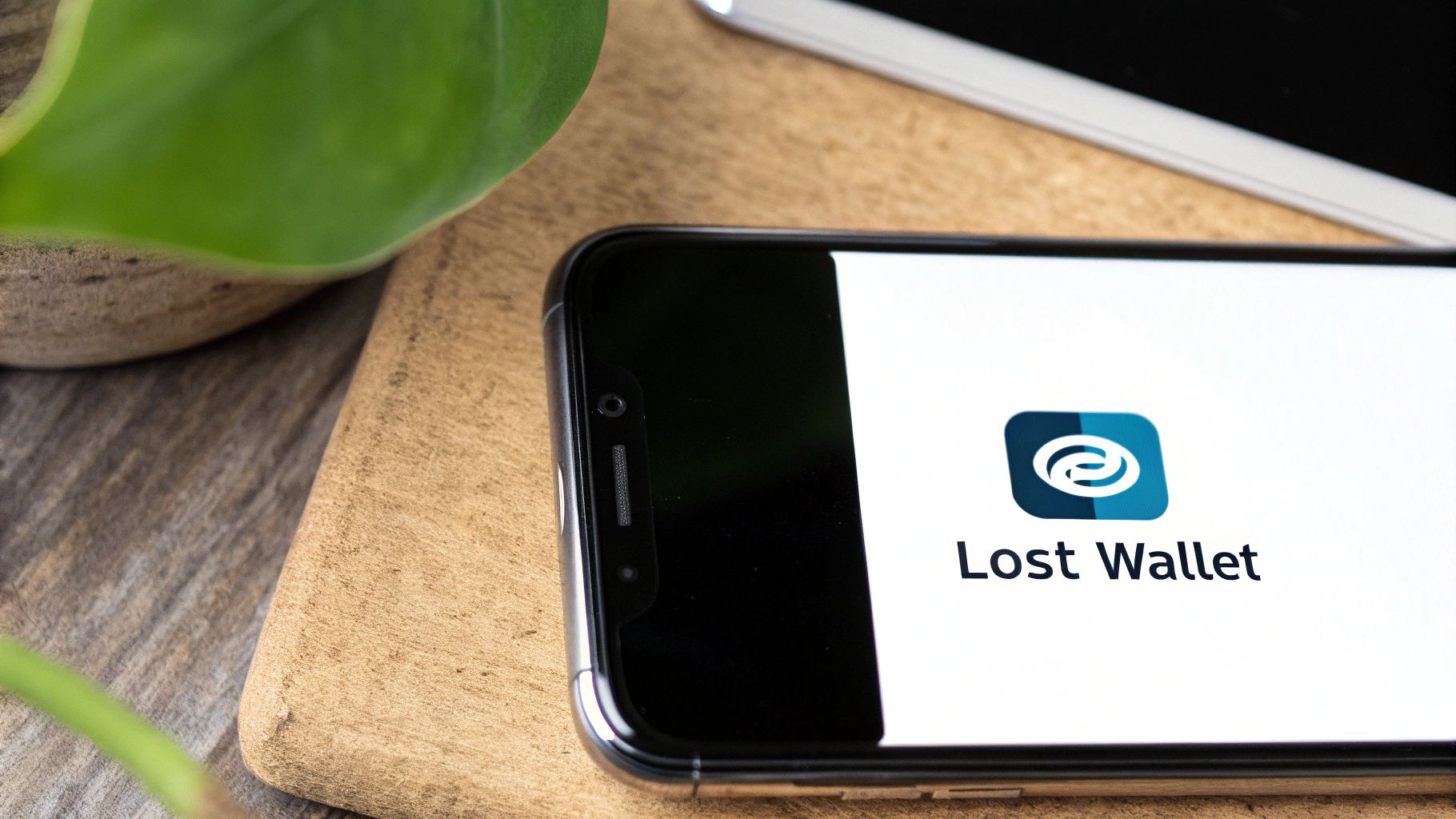
If you're locked out, it's easy to feel like you're the only one this has happened to. But you’re not. The crypto community is full of people who have been in your exact shoes. The reasons are almost always mundane—a simple mistake made years ago, a hard drive that suddenly died, or a piece of paper that got thrown out during spring cleaning.
This isn’t just a feeling; the numbers back it up. The sheer scale of inaccessible crypto is staggering.
As of early 2025, estimates suggest that between 2.3 million and 3.7 million Bitcoins are permanently lost. That's somewhere between 11% to 18% of the total supply, just sitting there, locked away forever. You can dig into more of this data on how many Bitcoin are lost on Ledger.com. Those coins are gone because of forgotten passwords, misplaced hardware wallets, and destroyed storage devices.
It happens all the time. But just because it's common doesn't mean your situation is hopeless.
Initial Diagnosis: What Went Wrong?
Before you can fix the problem, you need to know what you're dealing with. Every recovery mission starts by identifying the root cause. This quick table should help you pinpoint your issue and figure out the first logical step to take.
| Symptom | Common Cause | First Action Step |
|---|---|---|
| "Password Incorrect" Error | You've simply forgotten the password for your software or mobile wallet. | Begin organized password brainstorming and attempt structured recovery guesses. |
| Can't Find Your 12/24 Words | The paper or file with your seed phrase is lost, stolen, or destroyed. | Retrace your steps. Search all physical and digital storage locations methodically. |
| Hardware Wallet is Dead/Lost | Your device (e.g., Ledger, Trezor) is physically broken, lost, or won't power on. | Find your 24-word seed phrase. The device is replaceable; the phrase is not. |
| Wallet App Shows Zero Balance | The wallet file (wallet.dat, Keystore JSON) might be corrupted or you're on the wrong network. |
Try restoring from a backup file or re-syncing the blockchain data. |
Think of this as your diagnostic starting line. Identifying the what helps you focus your energy on the how and avoid wasting time on the wrong recovery path.
Common Scenarios That Lead to a Lost Wallet
Every recovery story I've heard starts with a different "how." Seeing how others got locked out can help you diagnose your own problem and realize that a solution is often well within reach. Most lockouts boil down to a few core issues:
- The Forgotten Password: You set up a software wallet on an old laptop years ago. You picked a super-secure password you were sure you’d remember. Now, that laptop is covered in dust and the password is a total blank.
- The Misplaced Seed Phrase: You did everything right. You wrote down your 12 or 24-word recovery phrase on a piece of paper and tucked it away somewhere safe. The problem is, after a move or a major cleanup, that "safe" place is now a mystery.
- Hardware Wallet Failure: Your trusty hardware wallet—your Ledger or Trezor—is physically busted, corrupted, or just won't turn on. Your keys are trapped inside that little piece of plastic.
- Corrupted Wallet File: The
wallet.datfile or keystore JSON file on your computer has been scrambled by a software bug, a virus, or a failing hard drive, and the wallet app can't read it anymore.
The first rule of wallet recovery is to stay calm and be methodical. Panic is your enemy. It leads to mistakes, like trying too many wrong passwords and getting locked out permanently, or worse, falling for a recovery scam.
Take a moment. Breathe. Approaching this logically will massively increase your chances of getting your funds back.
This guide is your roadmap. We’ll start by digging deeper into diagnosing your specific problem, then walk through the essential DIY recovery steps you can take right now. Finally, we'll look at how advanced tools like Wallet Recovery AI can step in when all else fails.
Your journey back to your funds starts now.
Your Foundational DIY Wallet Recovery Checklist
Before you let the panic set in, take a deep breath. Most of the time, getting locked out of a crypto wallet is solvable with a calm, methodical approach. Before you even think about calling in the experts, there are some foundational steps you can take yourself. These DIY checks are designed to tackle the most common lockout scenarios, which, more often than not, are just the result of simple human error.
Think of yourself as a digital archaeologist for a moment. You're searching for clues you left for yourself, maybe even years ago. Success here isn't about technical wizardry; it's about being patient and thorough. One of the biggest mistakes people make is rushing through this process or giving up too soon.
This flowchart breaks down the three main reasons you might be stuck.
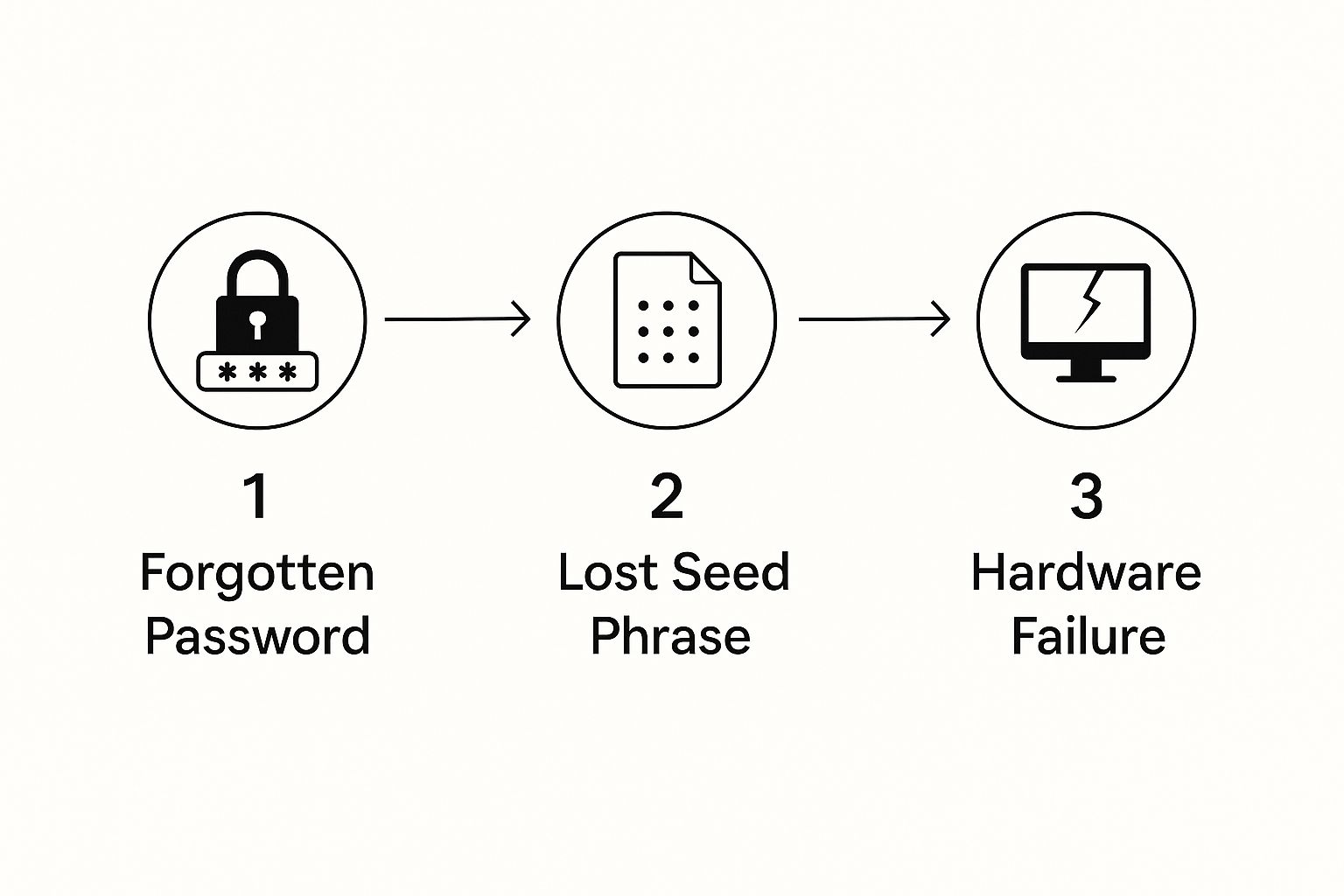
Whether it's a forgotten password, a misplaced seed phrase, or a busted hardware wallet, each problem requires its own focused search strategy.
Methodically Searching for Your Seed Phrase
Your seed phrase—sometimes called a recovery phrase—is the master key to your kingdom. If you have it, you can almost always get your funds back, no matter what happened to your device or password. Finding this should be your absolute top priority.
Don't just give your desk a quick once-over. Be systematic.
-
Physical Document Search: Start with the obvious places. Check your personal safe, filing cabinets (look in folders labeled "passwords," "finances," or "important docs"), and any notebooks you were using when you first set up the wallet. People love writing these things on the first or last page of a journal.
-
Unlikely Physical Locations: Now, think outside the box. Did you ever tape it to the back of a picture frame? Tuck it inside a favorite book? What about that messy box of old computer cables and USB drives? You need to revisit any spot you once thought was a "clever" hiding place.
-
Digital File Hunt: A lot of people save their seed phrase digitally, even though it's not the safest move. Use your computer’s search function to look for files created around the time you set up the wallet. Search for terms like "seed phrase," "recovery," "backup," "wallet," and the name of the crypto itself (e.g., "Bitcoin words").
-
Check Cloud Storage & Encrypted Archives: Go through your Dropbox, Google Drive, iCloud, and any other cloud accounts you use. Don't forget to check for password-protected ZIP files or encrypted disk images you might have created. The file name could be intentionally vague, so pay close attention to creation dates.
Remember, the person who hid your seed phrase was you. Try to get back into that mindset. What seemed like a secure and memorable location back then?
Jogging Your Memory for a Forgotten Password
If you're certain the seed phrase is gone but you still have the wallet file (like a wallet.dat or a Keystore JSON file), the password is your next target. Human memory is a funny thing, but it loves patterns.
First, create a master list of all your "usual" passwords. Don't just sit there trying them one by one in the wallet app—that's a good way to get locked out permanently. Build a comprehensive list first.
- Base Passwords: Jot down every core password you've ever used.
- Common Variations: We rarely invent brand-new passwords. We just tweak old ones. For each base password, create variations by adding your common modifiers:
- Numbers like 123, 1, or the year you created it (e.g., 2021).
- Special characters like !, ?, or # at the start or end.
- Capitalizing the first letter or the whole thing.
- Adding the name of the wallet or crypto (e.g., "MyPassExodus" or "MyPassBTC").
A simple spreadsheet can help you organize this and keep track of what you've tried. This kind of structured brainstorming is way more effective than just guessing randomly.
Troubleshooting a Hardware Wallet Issue
When a hardware device like a Ledger or Trezor gives up the ghost, the device itself isn't what matters. Your crypto isn't on the device; the device just holds the keys that access your funds on the blockchain. The only thing that matters for recovery is that 24-word seed phrase you were told to write down during setup.
If your device is just unresponsive, try some basic troubleshooting first:
- Use a different USB cable and a different port.
- Plug it into another computer to rule out a software or driver issue.
- Make sure the device's companion software is fully updated.
If none of that works and the device is truly broken or lost, don't panic. As long as you have that 24-word recovery phrase, your funds are 100% safe. You can simply buy a new device—from the same company or even a different one—and use your seed phrase to restore full access. What feels like a catastrophe is really just a minor inconvenience.
Figuring Out Exactly How You're Locked Out
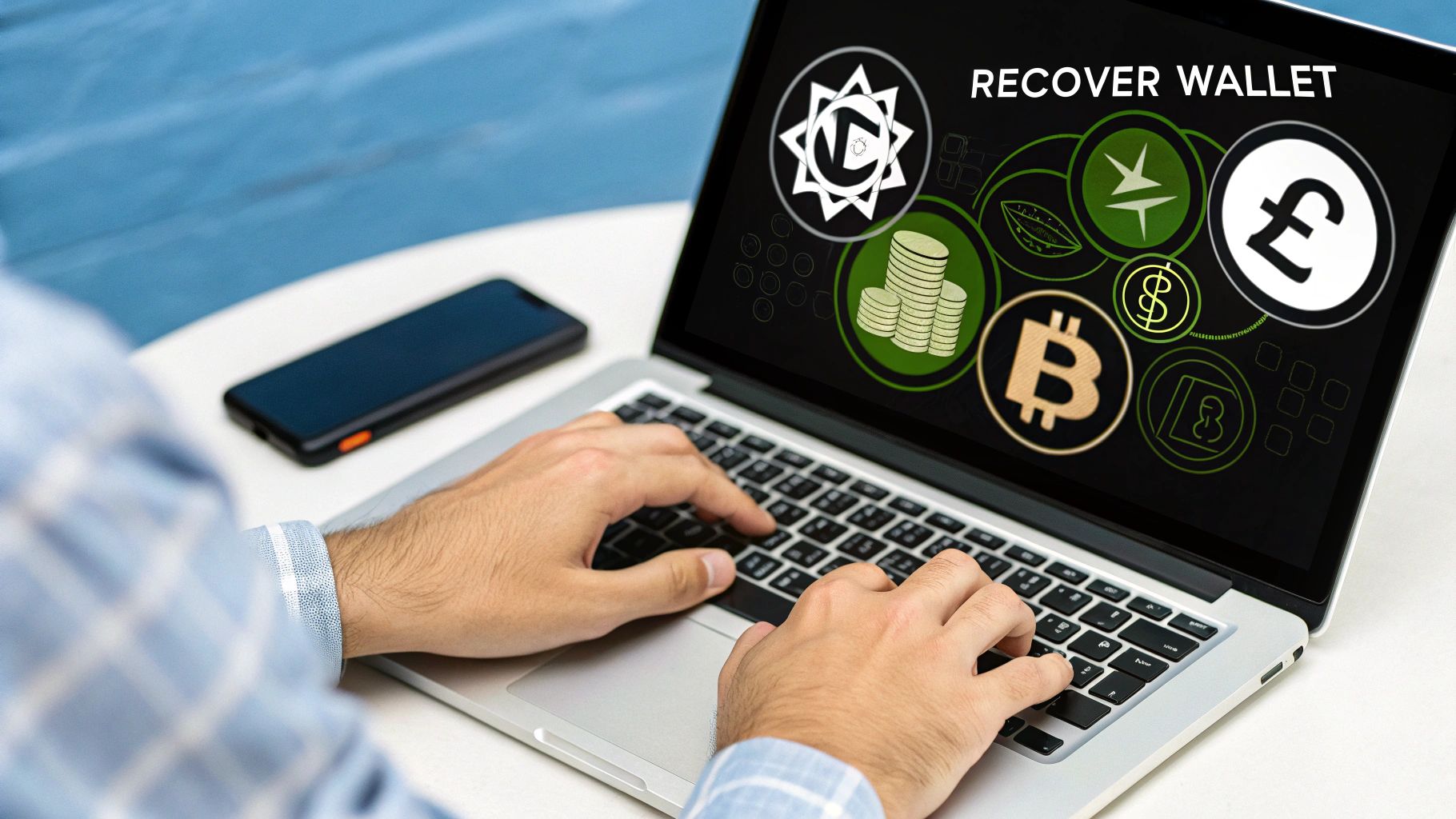
Let's get one thing straight: not all "lost wallet" situations are the same. Far from it. The recovery strategy that works for one scenario will be completely useless for another.
A forgotten password for a software wallet is a totally different beast than a hardware wallet that's been run over by a car. And both of those are worlds away from misplacing your 12-word seed phrase. Nailing down the specifics of your problem is the absolute first step.
This isn't just about managing expectations; it's about not wasting time on dead ends. Trying to "guess" a missing seed phrase is a fool's errand, but giving up on a forgotten password might mean leaving money on the table. The technical reality of your situation dictates which tools and techniques even have a prayer of working.
These simple mistakes have massive consequences. In 2024 alone, it's estimated that a staggering $1.5 billion in crypto was lost simply because of forgotten passwords or misplaced seed phrases. These aren't funds stolen by hackers—they're just sitting there, locked away forever because the owner can no longer prove they own them. You can dig into more of this data and how to regain access to your digital assets on i-ric.org.
Let’s break down the common predicaments.
Scenario One: The Forgotten Password
This is probably the most frequent—and most hopeful—situation. You still have the actual wallet file. Maybe it's a wallet.dat from an old Bitcoin Core installation, or a Keystore JSON file from MyEtherWallet. The file is safe, but the password to unlock it is gone from your memory.
Your funds are still there, just encrypted inside that file. The password is the only thing standing between you and them.
- What it means: The cryptographic keys are intact, just wrapped in a layer of protection you created.
- The path forward: This is prime territory for brute-force or dictionary-style attacks. If you have any memory of the password—fragments of words, its approximate length, special characters you always use—specialized software can systematically test millions of combinations.
- The catch: Success hinges entirely on how strong your original password was. Something simple like "Bitcoin123!" might be cracked in a few hours. A long, truly random password could take centuries with today's tech.
Scenario Two: The Lost Seed Phrase
This one is much more serious. Losing the 12 or 24-word seed phrase for a non-custodial wallet like MetaMask or Trust Wallet is a gut punch. That phrase isn't just a password; it is your money. It's the master key to everything.
With that phrase, you can recreate your wallet on any device, anywhere. Without it, the crypto tied to those addresses on the blockchain is effectively orphaned.
Key Takeaway: If your seed phrase is gone and you have no backup, the funds are, for all practical purposes, lost forever. There is nothing to "crack" or brute-force because the core information needed to access your funds is simply gone.
The only real hope here is to physically find where you originally wrote it down.
Scenario Three: The Damaged or Lost Hardware Wallet
A broken or missing hardware wallet from a brand like Ledger or Trezor feels like a complete disaster. But here's the good news: this is often a surprisingly easy fix, as long as you followed the setup instructions to the letter.
Your crypto was never on the device. The device just securely holds the private keys that sign your transactions.
- Your lifeline: That 24-word recovery phrase they made you write down during setup. That’s your entire safety net.
- The path forward: Just buy a new hardware wallet—it can even be from a different compatible brand—and use your original recovery phrase to restore full access. It’s that simple.
- The critical point: If you lost the device and you also lost the recovery phrase, you're right back in Scenario Two. The funds are likely gone for good.
By correctly identifying which boat you're in, you can focus your energy on a solution that actually has a chance. For password-related lockouts, recovery tools and services can be a game-changer. To see if your wallet is a candidate, you can check this list of supported wallets for AI-powered recovery services.
So, you’ve tried everything. You've racked your brain for every password variation, torn apart your office looking for that slip of paper with your seed phrase, and confirmed your hardware wallet is officially a paperweight. When you’ve hit a dead end, it’s easy to feel like it’s over.
But this is exactly the point where you should think about bringing in a specialist.
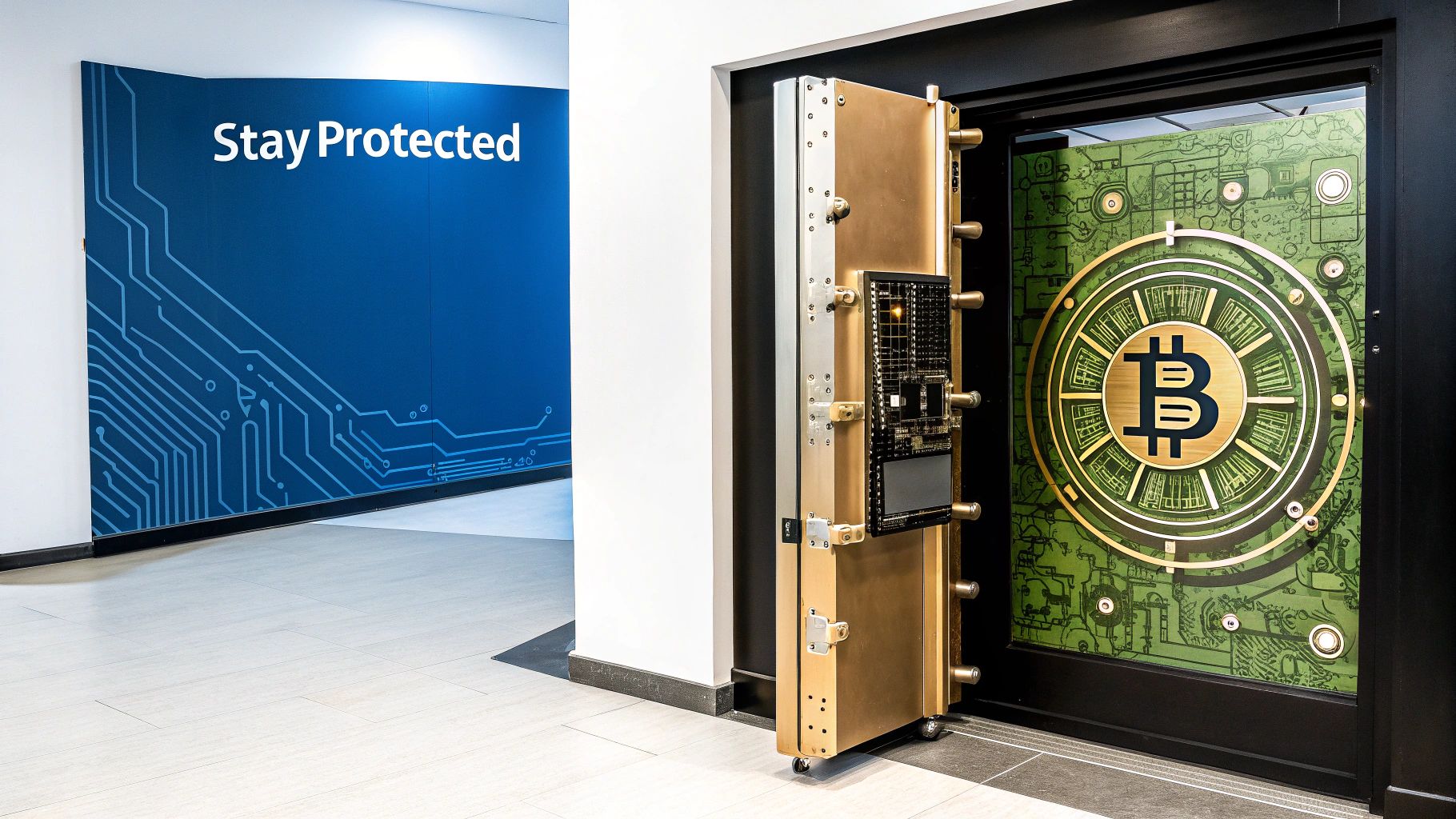
Let's be clear: professional recovery services aren't magicians. They can't pull a seed phrase you shredded out of thin air or guess a completely random password you forgot. Their expertise shines in very specific, technically demanding situations where specialized software and some serious computing power can crack the code.
They are at their best when you have most of the puzzle pieces. Think of it this way: if you remember parts of your password—like the first word, its approximate length, or the special characters you always use—a pro can run a highly targeted brute-force attack that’s light-years beyond what your home computer can do. Got a corrupted wallet.dat file? They have tools designed to repair the file structure and pry out the private keys.
Knowing When You Need an Expert
One of the hardest parts is knowing when to stop trying on your own. Pounding away with password guesses can sometimes trigger a permanent lockout, and trying to fix a corrupted file without the right tools can corrupt it beyond repair. It’s a tough pill to swallow, but sometimes you have to tag in an expert.
It's probably time to call for help if you're facing one of these scenarios:
- You have a partial password. You know some of the words, characters, or the general structure, but the exact combination is just out of reach.
- Your wallet file is corrupted. You're seeing errors like "failed to read wallet" or "invalid file format" when you try to open it.
- You need to access an old, obscure wallet. Some early wallet formats are a nightmare to access and require specific, often outdated software and deep technical knowledge.
- The value of the crypto justifies the cost. Let's be practical. Recovery services aren't free, so you have to weigh the potential reward against the service fee.
Deciding between a DIY approach and hiring a service is a big step. Each path has its own set of pros, cons, and risks that you need to consider carefully.
DIY Recovery vs Professional Services
| Factor | DIY Recovery Methods | Professional Recovery Services |
|---|---|---|
| Cost | Free (except for your time) | Typically a percentage of recovered funds (no-win, no-fee) |
| Success Rate | Low for complex issues (e.g., file corruption, partial passwords) | High for specific technical scenarios |
| Risk Level | High risk of permanent data loss or locking the wallet if done incorrectly | Low risk when using a reputable service with proper security protocols |
| Required Knowledge | Varies from basic to advanced technical skills | None required on your part |
| Best For | Simple cases like a forgotten password with good hints, or finding a lost seed phrase | Corrupted files, partial password recovery, complex hardware failures |
Ultimately, DIY is great for simple memory lapses, but when you're dealing with technical failures, a professional service dramatically increases your odds of success without risking further damage.
How To Spot a Reputable Recovery Service
Sadly, the wallet recovery world is full of sharks who prey on desperation. Your urgency to get your funds back makes you a perfect target. A legitimate service will never ask for your seed phrase or demand huge upfront payments with pie-in-the-sky guarantees.
Critical Warning: Never, ever share your seed phrase with anyone claiming they can help you. A real pro will work with an encrypted copy of your wallet file and will never need your master key to do their job.
When you're vetting a service, keep an eye out for these green flags:
- Transparent Fee Structure: They should be upfront about their fees. Most charge a percentage of the recovered funds, and you only pay after you get your crypto back.
- A Proven Track Record: Look for real testimonials, detailed case studies, and a professional online presence. Fly-by-night operations rarely have these.
- Strong Security Protocols: Ask them about their process. They should be able to clearly explain how they handle your data securely from start to finish.
- No-Success, No-Fee Policy: The most trustworthy services operate on a contingency basis. If they can't get your funds back, you shouldn't owe them a dime.
If you think a professional is your best shot, it's time to find the right one. To see if your situation is a good match for our methods, you can get a secure, no-obligation assessment by starting a confidential inquiry with Wallet Recovery AI. Taking that step might just be the turning point that gets your crypto back where it belongs.
From Recovery to Resilience: Building a Bulletproof Wallet Security Strategy
Getting back into your crypto wallet after being locked out is a massive win, but don't stop there. This is the perfect moment to rethink your security from the ground up so you never have to feel that panic again. Honestly, preventing a lockout is a whole lot less stressful than recovering from one.
This isn't about becoming a cybersecurity expert overnight. It's about building a few simple, rock-solid habits. A strong security foundation starts with a single mindset shift: you are the sole guardian of your digital wealth. You are your own bank, and that means taking security seriously.
Mastering Your Seed Phrase
Your seed phrase—that list of 12 or 24 words—is the single most important piece of crypto information you will ever own. It's the master key that can bring your entire wallet back to life on any device. Protecting it isn't just a good idea; it's the absolute bedrock of your security.
So many people trip up by storing it digitally. A plain text file on your desktop, a note in your phone, or a draft in your email is just asking for trouble. Those are the first places hackers and malware look. The only real solution is to go old-school with offline, physical storage methods that can survive both digital theft and physical disasters.
I’ve seen these methods work time and time again:
- Steel Plates: Go for something permanent. Engraving or stamping your seed phrase onto a metal plate makes it practically indestructible—resistant to fire, water, and just about anything else you can throw at it. Brands like Cryptosteel or Billfodl are built for exactly this. It's a one-time cost for a lifetime of security.
- Laminated Cards: If you're looking for a simpler, low-cost route, write your phrase clearly on a few high-quality cards. Laminate them to protect against water damage and store them in different, secure locations.
- Geographic Distribution: This one is critical. Never, ever keep all your backups in one place. A fire, flood, or burglary could wipe out your only copy in an instant. The goal is redundancy. Keep at least two copies in separate, secure physical locations—think a safe at home and another at a trusted family member's house or in a bank's safe deposit box.
The golden rule for seed phrases is simple: Never store it digitally. Never share it with anyone. Never take a photo of it. Treat it like it's worth its weight in gold, because it is.
Level Up with Multi-Signature Wallets
As your crypto portfolio grows, relying on a single password or a single hardware device becomes a huge risk. That single point of failure is a magnet for problems. This is where multi-signature (multisig) wallets change the game. A multisig wallet is set up to require two or more private keys to sign and send a transaction.
Think of it like a bank vault that needs two different keys, held by two different people, to open. It's an incredibly powerful defense against both theft and accidental loss.
For example, a common setup is a 2-of-3 multisig:
- Key 1: Stored on your main computer.
- Key 2: Kept on a hardware wallet like a Ledger or Trezor.
- Key 3: Backed up securely offline, perhaps on a steel plate in a safe.
To move any funds, you'd need to approve the transaction with any two of those three keys. So, if a hacker gets into your computer and steals Key 1, they still can't do anything. They're stuck. And if you lose your hardware wallet (Key 2), you can still access your funds with Key 1 and Key 3. This built-in backup plan is a game-changer.
Run Regular Security Audits on Yourself
Your security plan isn't a "set it and forget it" kind of thing. It needs regular check-ups, just like your car or your health. A quick, regular audit helps you spot and fix weak points before they turn into real problems.
Put a reminder in your calendar—every six months is a good rhythm. During your audit, walk through these questions:
- Are my backups still safe? Go and physically look at your seed phrase backups. Are they still in good condition, legible, and where you expect them to be?
- Is my software updated? Make sure your wallet software, computer's operating system, and any antivirus programs are running the latest versions. Updates often contain critical security patches.
- Has anything in my life changed? If you've moved, had a change in your family situation, or found a new storage spot, it’s time to review your security plan to make sure it still makes sense.
This proactive mindset is essential. Threats aren't just local; they're global and around the clock. Wallet victimization data shows clear patterns, with users in countries like the U.S., Germany, and Japan frequently targeted. This just highlights that no one is immune, and strong security is a universal need. You can dive deeper into the global scope of these threats and explore the latest crypto crime updates from Chainalysis.
By combining offline seed phrase storage, the advanced protection of a multisig setup, and disciplined security audits, you build a truly resilient system. This isn't just about avoiding another lockout—it's about giving you the confidence to focus on your investments without constantly looking over your shoulder.
Common Questions About Wallet Recovery
When you're staring at a locked wallet, a million questions race through your mind. It's a stressful situation, and getting clear answers is the first step toward figuring out what to do next. Let's tackle some of the most common things people ask when they're in this exact spot.
"Is a password the same as a seed phrase?"
This is probably the biggest point of confusion, and it’s critical to understand the difference. They are absolutely not the same thing.
Think of your password as the key to a specific app on your computer or phone. It encrypts the local wallet file, like wallet.dat, so no one can use it on that device without your permission.
Your seed phrase (or recovery phrase) is the master key to your actual funds on the blockchain. It's a list of 12 or 24 words that can recreate your entire wallet—all your private keys and addresses—from scratch on any device, anywhere.
Simply put: a forgotten password might be recoverable. A lost seed phrase for a self-custody wallet almost always means your funds are gone for good.
"How long will this take?"
Everyone wants their funds back yesterday, but the honest answer is: it depends. The timeline for a professional recovery can vary wildly depending on what we're up against.
A simple password recovery, where you can give us a few solid clues—like parts of the password or a pattern you always use—might only take a few hours or a couple of days. But some situations are much tougher nuts to crack.
- Corrupted Wallet Files: If the wallet file itself is damaged, it might need serious repair work that could take several weeks.
- Tough Brute-Force Jobs: Trying to crack a strong, completely unknown password could mean running our systems for months.
The goal is to be thorough, not just fast. Rushing the process is how mistakes happen.
"Can't you just recover it from my public address?"
I get this question a lot, and unfortunately, the answer is a hard no.
Your public address is like your bank account number. It’s perfectly safe to share it so people can send you crypto. But just like a bank account number, it gives you zero power to actually withdraw or spend the money inside.
Only the private key, which is mathematically generated from your seed phrase, can authorize a transaction. Without that private key, the funds are visible on the blockchain but completely untouchable.
"Are recovery services safe to use?"
This is a question you absolutely should be asking. While reputable services are safe, the crypto world has its fair share of scammers preying on desperate people.
A legitimate recovery expert or service will have a transparent process, a clear fee structure (usually a percentage of what’s recovered, paid after success), and a solid public reputation. Be extremely careful with anyone asking for your seed phrase or demanding large payments upfront with pie-in-the-sky guarantees. Always do your homework before trusting anyone with your files.
If you've hit a wall and need professional help, Wallet Recovery AI uses a secure, AI-powered approach to give you the best chance of getting your funds back. Start your confidential inquiry today.
Article created using Outrank

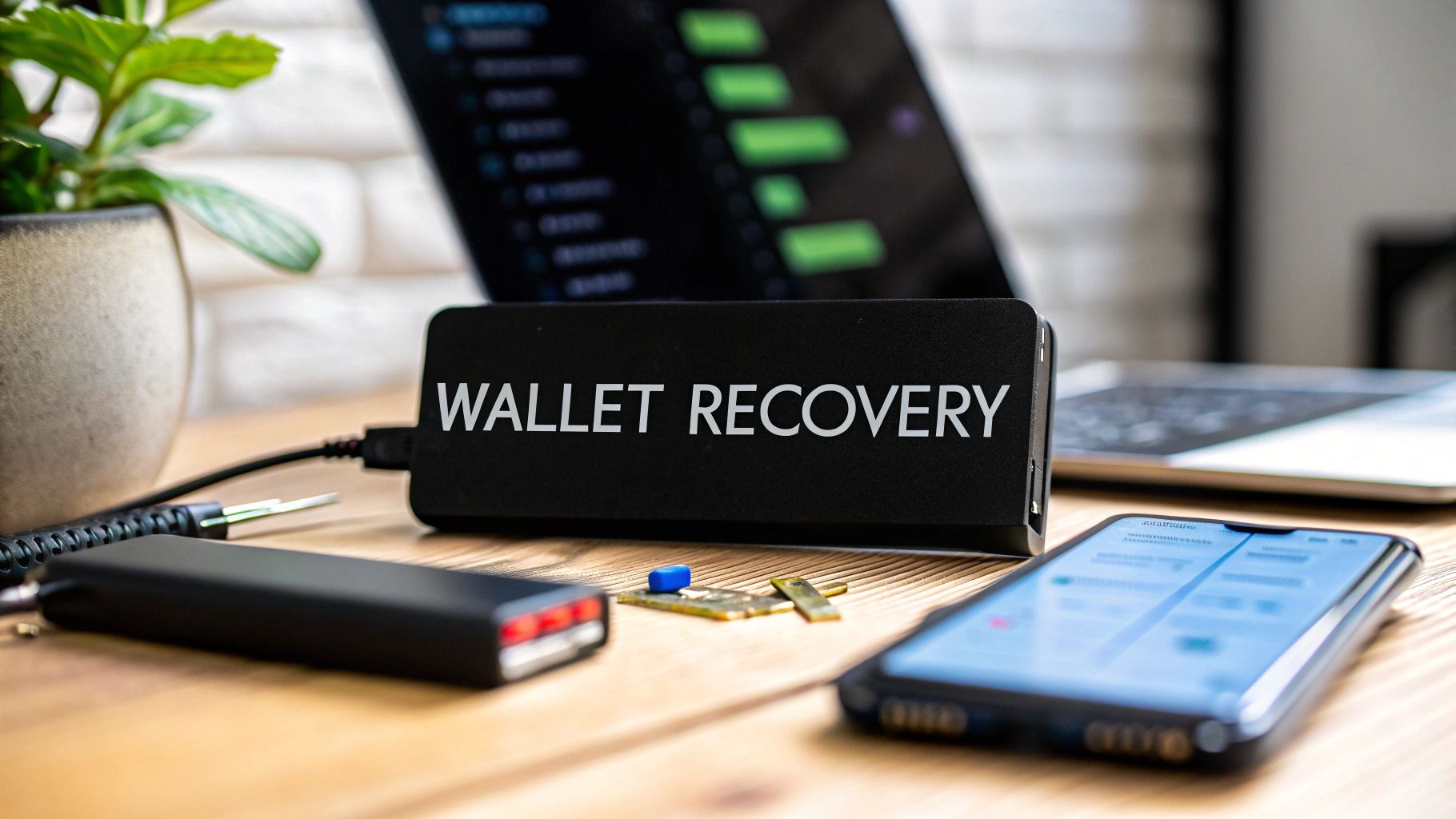
Leave a Reply